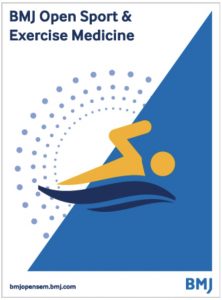Publications

Diurnal variations in the expression of core-clock genes correlate with resting muscle properties and predict fluctuations in exercise performance across the day
Authors: Alireza Basti 1, 2, 3, Müge Yalçin 1, 2, David Herms 2, 4, Janina Hesse 1, 2, 3, Ouda Aboumanify 1, 2, Yin Li 1, 2, Zita Aretz 1, 2, Josefin Garmshausen 1, 2, Rukeia El-Athman 1, 2, Maria Hastermann 5, Dieter Blottner 5, Angela Relógio 1, 2, 3
Affiliations:
- Molecular Cancer Research Center (MKFZ), Medical Department of Hematology, Oncology, and Tumor Immunology, Charité – Universitätsmedizin Berlin, corporate member of Freie Universität Berlin Humboldt – Universität zu Berlin, and Berlin Institute of Health, Berlin, Germany
- Institute for Theoretical Biology (ITB), Charité – Universitätsmedizin Berlin, corporate member of Freie Universität Berlin, Humboldt – Universität zu Berlin, and Berlin Institute of Health, Berlin, Germany
- Institute for Systems Medicine and Bioinformatics, Department of Human Medicine, MSH Medical School Hamburg, Hamburg, Germany
- Karate Department, Berliner Turn- und Sportclub e.V, Berlin, Germany
- Center of Space Medicine Berlin, NeuroMuscular Group and Institut für Integrative Neuroanatomie, Charité – Universitätsmedizin Berlin, corporate member of Freie Universität Berlin, Humboldt – Universität zu Berlin, and Berlin Institute of Health, Berlin, Germany
Journal: BMJ Open Sport & Exercise Medicine - January 2021, Volume 7, Issue 1 (DOI: 10.1136/bmjsem-2020-000876)
-
Field & Applications:
- Sport
- Muscle development / Performance
- Warm-up / Recovery
- Fatigue / Overtraining
- Muscle symmetry
- Injury prevention
- Medical
- Musculoskeletal rehabilitation
- Physiotherapy
- Treatment evaluation
-
BMAL1 and PER2 expression show daily changes in human blood, hair and saliva cells, which are distinctive for every individual tested.
-
Sport performance displays daily variations between 9h, 12h, 15h and 18h and peak performance is time-of-day dependent, with different optimal timing for strength exercises as compared with endurance exercises.
-
Biomechanical muscle properties in resting muscles undergo daily fluctuations, which correlate with exercise performance and clock gene expression variations observed in saliva.
-
Salivary gene expression of BMAL1 and PER2 can potentially serve as personalised predictors of exercise performance fluctuations and individual peak times in performance.
Objectives: In this study, we investigated daily fluctuations in molecular (gene expression) and physiological (biomechanical muscle properties) features in human peripheral cells and their correlation with exercise performance.
Methods: 21 healthy participants (13 men and 8 women) took part in three test series: for the molecular analysis, 15 participants provided hair, blood or saliva time-course sampling for the rhythmicity analysis of core-clock gene expression via RT-PCR. For the exercise tests, 16 participants conducted strength and endurance exercises at different times of the day (9h, 12h, 15h and 18h). Myotonometry was carried out using a digital palpation device (MyotonPRO), five muscles were measured in 11 participants. A computational analysis was performed to relate core-clock gene expression, resting muscle tone and exercise performance.
Results: Core-clock genes show daily fluctuations in expression in all biological samples tested for all participants. Exercise performance peaks in the late afternoon (15–18 hours for both men and women) and shows variations in performance, depending on the type of exercise (eg, strength vs endurance). Muscle tone varies across the day and higher muscle tone correlates with better performance. Molecular daily profiles correlate with daily variation in exercise performance.
Conclusion: Training programmes can profit from these findings to increase efficiency and fine-tune timing of training sessions based on the individual molecular data. Our results can benefit both professional athletes, where a fraction of seconds may allow for a gold medal, and rehabilitation in clinical settings to increase therapy efficacy and reduce recovery times.
The characterisation of an individual’s clock (ie, circadian rhythms) based on the expression of clock genes can aid to schedule different daily activities or exercise sessions with profound implications for physiology and exercise performance. Our data showed higher exercise performance in the late afternoon, in agreement with previous data with significant variations in performance, depending on the type of exercise (eg, strength vs endurance) and the individual. In addition, expression of core-clock genes and muscle tone changed during the course of the day and a higher resting muscle tone correlated with better performance both in female and male participants.
Various training programmes can profit from these findings to increase outcome efficiency. For example, high-performance athletes often have two training sessions a day, according to our results training sessions that require mostly strength should be carried out in the mid afternoon while exercises that require more endurance capacity rather in the late afternoon and evening. The timing of the training session can be further fine-tuned based on the individual molecular data for the core-clock genes.
Both professional athletes, for whom a fraction of a second decides on a gold medal, and individuals who have the possibility to organise their physical training at different times of the day can benefit from it. Also the efficacy of rehabilitation programmes or general training protocols can likely be optimised and increased if the training is adapted to the circadian rhythms of each individual. This can be achieved by personalised circadian rhythm analysis with simple non-invasive tests and implemented in future training scenarios.


